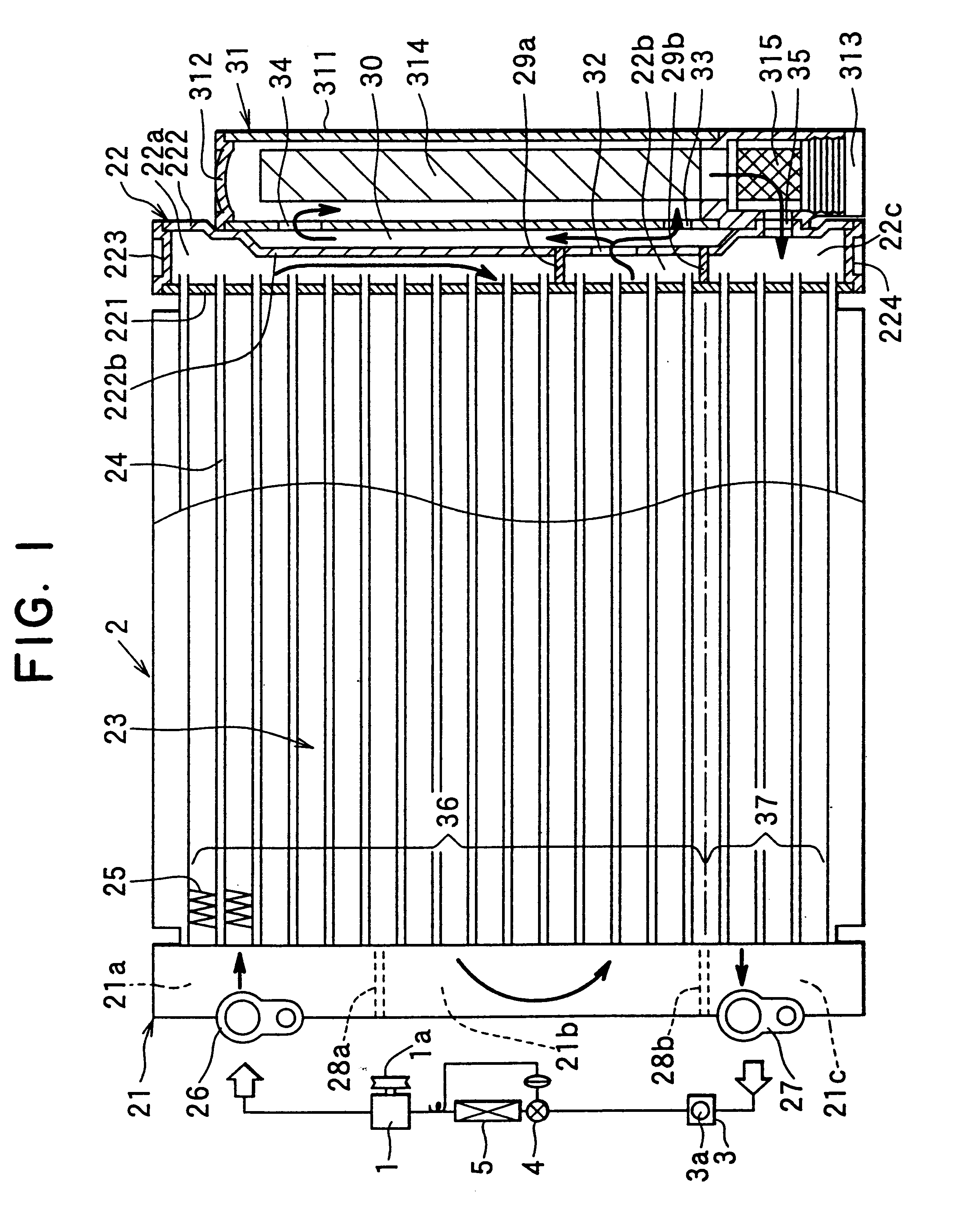Receiver and refrigerant cycle system
a technology of refrigerant cycle and receiver, which is applied in the direction of subcoolers, refrigeration machines, lighting and heating apparatus, etc., can solve the problems of deteriorating refrigerant sealing performance of the refrigerant cycle, difficult to maintain the super-cooling degree in a predetermined range, and difficult to cool an upper side of the receiver
- Summary
- Abstract
- Description
- Claims
- Application Information
AI Technical Summary
Benefits of technology
Problems solved by technology
Method used
Image
Examples
first embodiment
A first preferred embodiment of the present invention will be now described with reference to FIGS. 1-4. In the first embodiment, the present invention is typically applied to a refrigerant cycle of an automotive air conditioner. As shown in FIG. 1, The refrigerant cycle of the automotive air conditioner includes a refrigerant compressor 1, a receiver-integrated refrigerant condenser 2, a sight glass 3, an expansion valve 4, and a refrigerant evaporator 5. All of components of the refrigerant cycle are serially connected by a metal pipe or a rubber pipe to form a closed circuit.
The compressor 1 is connected to an engine disposed within an engine compartment through a belt and an electromagnetic clutch 1a. When the rotation power of the engine is transmitted to the compressor 1 through the electromagnetic clutch 1a, the compressor 1 compresses gas refrigerant sucked therein from the evaporator 5 and then discharges high-pressure high-temperature gas refrigerant to the receiver-integr...
fifth embodiment
In the fifth embodiment, the second separator 28b is disposed in the first header tank 21 at the same height position as the third separator 28c disposed in the second header tank 22. Therefore, the core portion 23 of the condenser 2a is separated into the a condensing portion 36 and a super-cooling portion 37.
The first inlet pipe 46 is connected to the first header tank 21 at a position upper than the first separator 28a to communicate with the upper space 21a. The second inlet pipe 47 is connected to the first header tank 21 at a position lower than the second separator 28b to communicate with the lower space 21c. A first outlet pipe 48 through which refrigerant condensed in the condensing portion 36 of the core portion 23 of the condenser 2a is introduced into the receiver 31a is connected to the first header tank 21 to communicate with a lower side of the intermediate space 21b. Further, a second outlet pipe 49 through which refrigerant from the super-cooling portion 37 of the c...
eighth embodiment
In the eighth embodiment, the three communication holes 51, 52, 53 and tube-insertion holes 54 are opened after the aluminum extrusion. Further, both upper and lower opened ends of the receiving unit 31 and the first header tank 21 are closed by cap members 55, 56.
In the eighth embodiments, both the first header tank 21 and the receiving unit 31 may be integrally bonded by brazing after being separately formed.
In the above-described fifth through eighth embodiments, the super-cooling portion 37 can be independently separately formed from the core portion 23. Even in this case, the present invention can be applied. Further, the super-cooling portion 37 can be omitted, and the refrigerant outlet of the receiver may be directly coupled to the sight glass 3.
PUM
 Login to View More
Login to View More Abstract
Description
Claims
Application Information
 Login to View More
Login to View More - R&D
- Intellectual Property
- Life Sciences
- Materials
- Tech Scout
- Unparalleled Data Quality
- Higher Quality Content
- 60% Fewer Hallucinations
Browse by: Latest US Patents, China's latest patents, Technical Efficacy Thesaurus, Application Domain, Technology Topic, Popular Technical Reports.
© 2025 PatSnap. All rights reserved.Legal|Privacy policy|Modern Slavery Act Transparency Statement|Sitemap|About US| Contact US: help@patsnap.com



